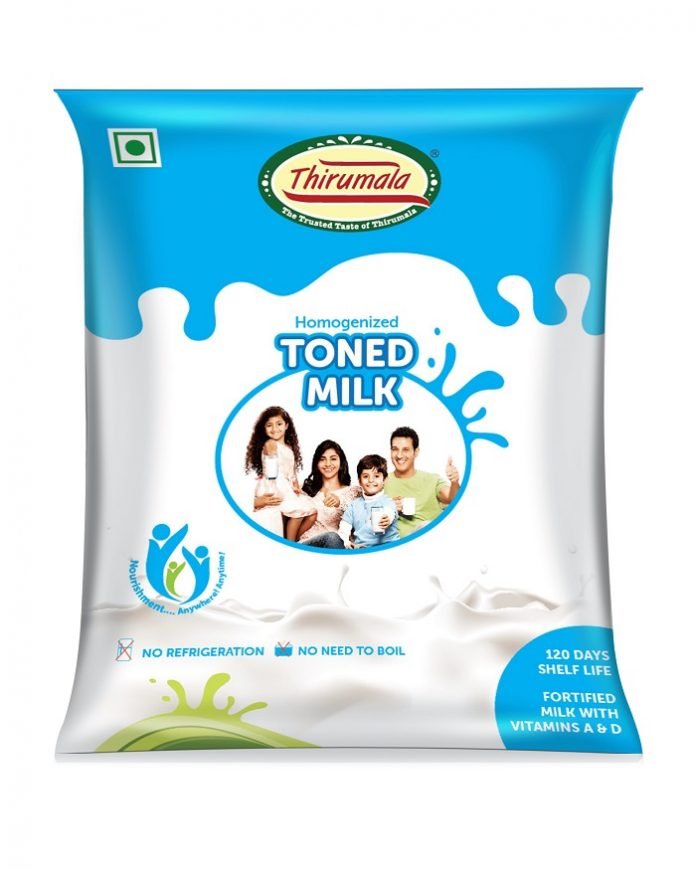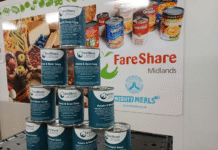India is a fast growing economy with both the urban and the rural lifestyles and food habits changing and becoming more modern. This has led to the consumption of more and more packaged foods across the socio-economic spectrum. However, a recent report published in the media revealed that a majority of the complaints received by the FSSAI from the market are attributed to food packaging (or packaged food). This raises a severe concern on the food safety aspects of the packaged food we eat in our daily lives. The officials are sensitive to the issue and have encouraged food brand owners to put in place a robust system to redress consumer grievances. They have also advised big brands to avoid complacency when it comes to the safety of food products.
The primary purpose of any packaging material is to safeguard food products from physical, chemical as well as microbial contaminants. However, the very packaging that is supposed to protect can serve as a potential source of chemical contaminants. It needs to be specifically highlighted that packaging inks, which are an integral part of all the packaging material available in the market, play a prominent role as a source of such potential contaminants. Packaging inks are nothing more than a mixture of raw materials also containing Non Intentionally Added Substances (NIAS). Such NIAS may come from impurities in the raw materials used in previous production steps, but can also be a result of contamination in the production or handling of ink. Special attention is required – as some of these chemicals are harmful or even toxic and have been recognized to have migration potential.
History of migration
Long before the public became aware, a number of scientific publications had already revealed the migration potential of substances present in print. Scientific literature concerning the transfer of low molecular plasticizers from flexible packaging printed with solvent-based inks to fatty snack foods was published in 1989; and to confectionery, chocolate bars, biscuits, potato crisps and other products, in 1993. Beverage cartons printed with water-based inks were shown to transfer a low molecular surfactant in detectable quantities to mineral water in articles published in 1998. Migration of the very low molecular photo initiator ‘benzophenone’ was measured in shelf-stable, refrigerated, frozen and microwaveable food packed in cardboard printed with UV inks (2000, 2003). In the US, the 1999 – 2000 National Health and Nutrition Survey detected phthalate metabolites in more than 75% of the US population.
Major ink to food migration scandal of 2005 in Europe
All this knowledge about the migration of low molecular substances from printed layers and surfaces did not spread. Instead, it remained largely unnoticed by the decision-makers in the packaging chain. But everything changed with the first big migration scandal in 2005. Findings of isopropyl thioxanthone (ITX, a low molecular photo initiator used in UV inks) in baby milk and other liquid foodstuffs (the ‘ITX case’) were reported, all over Europe, in the year 2005 and caused several product recalls. This food scandal alerted the packaging chain about the migration potential of substances from printing inks.
Again in early 2009, new findings of the two UV curing photo initiators ‘4 methylbenzophenone (4-MBP)’ and ‘benzophenone’ above the acceptable thresholds in breakfast cereal packed in polyethylene pouches included in cardboard boxes boxes also gained huge media coverage followed by recalls, bringing considerable financial losses to the affected companies and a negative image to the food production industry as a whole. Apart from these also, there have been several studies and reports supplementing the evidences of migration from inks and its impact on food safety.
In addition to global scandals, recently we have seen reports in India where popular drink brands were found to be contaminated with chemicals like phthalates and mineral oils. Moreover, FSSAI itself had issued a nationwide advisory to restrict newspapers usage for wrapping and packing foodstuff highlighting the presence of multiple bioactive materials with negative health effects in inks used for newspaper printing. They have clearly indicated that newspapers and paper or cardboard boxes are a source of metallic contaminants, mineral oils and several harmful chemicals like phthalates. However, the logical question is while we have raised our concerns about inks used in newspapers, have we given a thought to inks used in packaging materials which have a much wider population exposure than newspapers.
Food safety and migration
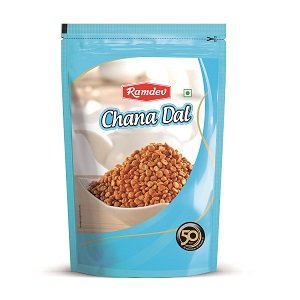 Food packaging has been an underestimated source of chemical food contamination which if ignored further will lead to serious health safety risks for future generations. As mentioned above, chemicals from the packaging material (including packaging inks) have the potential to come into contact with the food and result in severe food safety issues through a process called migration. Migration can be described as transfer of chemical contaminants from the food packaging material to food, thereby making it unsafe. Migrants from packaging inks due to their chemical characteristics and molecular size have the potential to move from the printed layer to the packed food.
Food packaging has been an underestimated source of chemical food contamination which if ignored further will lead to serious health safety risks for future generations. As mentioned above, chemicals from the packaging material (including packaging inks) have the potential to come into contact with the food and result in severe food safety issues through a process called migration. Migration can be described as transfer of chemical contaminants from the food packaging material to food, thereby making it unsafe. Migrants from packaging inks due to their chemical characteristics and molecular size have the potential to move from the printed layer to the packed food.
Types of migration
1. Set-off migration
Migrants can migrate from one layer to another, such as a surface printed layer to the non-printed food-contact surface which is later on brought into contact with food. If these are in direct or close contact as in a reel or a stack after printing, set-off migration can easily occur due to the pressure existing in the reel or stack.
2. Diffusion migration
Small and mobile molecules can easily penetrate into and diffuse across packaging material layers. This can occur even if the printed material has not yet been converted into a food package and filled with food, or later on when the printed package is filled with food and the food starts to ‘extract’ the migrants from the packaging material.
3. Gas-phase migration
Migrants can also migrate from a cardboard (the ‘releasing reservoir’) via the gas phase within the pack, to end up in food, which acts as ‘recipient reservoir’ (gas phase migration). This can, for example, occur with migrants such as mineral oils or some UV photoinitiators that might not be generally known as being volatile such as organic solvents.
This process of migration is influenced by several factors such as the physiochemical properties of the migrant; of packaging material and of the food product; storage time and temperature; and, the surface area of the packaging material in proportion to food volume.
Legal and regulatory compliances
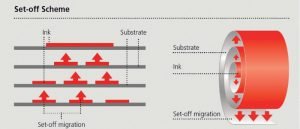 Globally there are several regulations adopted by different countries to protect food packaging but with the changing scenario, packaging is no longer considered to be an outsourced activity and hence more and more emphasis is been laid to make safe packages and above all safe food products. Hence, many different
Globally there are several regulations adopted by different countries to protect food packaging but with the changing scenario, packaging is no longer considered to be an outsourced activity and hence more and more emphasis is been laid to make safe packages and above all safe food products. Hence, many different
countries have adopted specific guidelines for food contact materials or even packaging inks in order to make sure that food safety is ensured holistically. Given below is a table enlisting the countries which have made a move forward to ensure safe packaging by adopting regulatory amendments specifically pertaining to packaging inks.
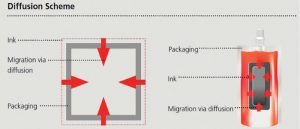 In India, the “Food Safety and Standards Act” (FSSA, No. 34 of 2006) introduces regulation on food contaminants, in particular including contaminants from packaging. Specific provisions on packaging are detailed out in the “Food Safety and Standards (Packaging and Labelling) Regulations, 2011.” Section 2.1.1 (2) regulates plastics in contact with food, stating generally that “containers made of plastic materials should conform to the following Indian Standard Specification (IS)” (followed by a list of 10 Indian Standards on 10 different plastic types previously issued by the Bureau of Indian Standards) which takes into account overall migration.
In India, the “Food Safety and Standards Act” (FSSA, No. 34 of 2006) introduces regulation on food contaminants, in particular including contaminants from packaging. Specific provisions on packaging are detailed out in the “Food Safety and Standards (Packaging and Labelling) Regulations, 2011.” Section 2.1.1 (2) regulates plastics in contact with food, stating generally that “containers made of plastic materials should conform to the following Indian Standard Specification (IS)” (followed by a list of 10 Indian Standards on 10 different plastic types previously issued by the Bureau of Indian Standards) which takes into account overall migration.
Food packaging inks standard in India – IS 15495:2004
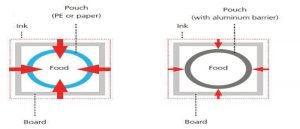 The Bureau of Indian Standards already moved some way forward years ago, by creating a specific standard on food packaging inks, that is, IS 15495:2004. The standard developed by BIS has been regularly reviewed and updated by prominent ink manufacturers in the country to make sure they play their role in the supply chain in safeguarding the food safety aspects for Indian customers. However, unless and until the standard is officially recognized and adopted by the FSSAI in their regulations, it will more or less be voluntarily adopted and malpractices in the market will continue impacting food safety and hence impacting the health of Indian customers.
The Bureau of Indian Standards already moved some way forward years ago, by creating a specific standard on food packaging inks, that is, IS 15495:2004. The standard developed by BIS has been regularly reviewed and updated by prominent ink manufacturers in the country to make sure they play their role in the supply chain in safeguarding the food safety aspects for Indian customers. However, unless and until the standard is officially recognized and adopted by the FSSAI in their regulations, it will more or less be voluntarily adopted and malpractices in the market will continue impacting food safety and hence impacting the health of Indian customers.



